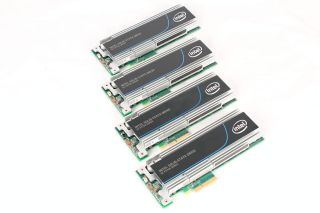LDPC Bears Fruit: Intel Extends Endurance Rating Of DC P3700 SSDs
LDPC error correction codes were a hot topic among the SSD controller vendors at Computex 2015. As flash shrinks, or when more bits are added per cell (such as TLC NAND), errors become more prevalent and outstrip the capabilities of standard BCH ECC. To keep reliability within expectations as 15nm and 16nm TLC NAND become prevalent, the manufacturers simply have no choice but to move to LDPC or other forms of advanced error correction. Unfortunately, LDPC has been slow to come to market.
Not long ago, we noticed Intel changed the endurance rating of its 1.6 TB and 2 TB DC P3700 data center SSDs from the 10 DWPD (Drive Writes Per Day) listed at launch to 17 DWPD. We found it odd that Intel did not make a public announcement of the relatively large change to the endurance rating. I would expect Intel to be quite vocal now that some of its SSDs are offering nearly double the endurance as before.
We reached out for comment and Jonmichael Hands, Product Marketing Manager of Data Center Solid-State Drives at the Intel Non-Volatile Memory Solutions Group, replied with more information.

"The new NVMe controller has better error correction, further extending the capabilities of our HET (High Endurance Technology) NAND, to make the 2 TB Intel SSD DC P3700 Series have endurance of up to 17 DWPD, at worst case. In certain cases, including primarily sequential write usage, users may see higher total terabytes written (TBW) than the 17 DWPD rating. We use binning to select the very highest endurance NAND for use in the DC P3700 Series, but it is the same 20nm NAND technology used in the full family of SSDs."
The company revealed that the better error correction leverages LDPC technology after a series of follow-up questions. The introductory DC P3700 specifications were based upon the lowest common denominator and the endurance rating was altered to mirror the actual performance in the field.
This is eyebrow raising because Intel never revealed the type of error correction when the series launched back in June of 2014. It turns out that Intel apparently has a big lead in the LDPC race while other SSD vendors are still in development.
Intel's SSD 750 Series, the first NVMe SSDs for consumers, are built upon the same architecture as the bleeding-edge enterprise DC P3x00 series. These SSDs utilize the same controller, and they are likely using the same error correction technology. The enterprise-centric DC P3700 series also has two lower-endurance variants, the DC P3600 and the DC P3500, that utilize lower-quality NAND to provide more economical price points, making LDPC an obvious choice to extend endurance.
Stay on the Cutting Edge
Join the experts who read Tom's Hardware for the inside track on enthusiast PC tech news — and have for over 25 years. We'll send breaking news and in-depth reviews of CPUs, GPUs, AI, maker hardware and more straight to your inbox.
Intel also recently announced its move to 16nm NAND for some of its newer 2.5" SSD products, and it wouldn't be entirely surprising to find the company leveraging LDPC in 2.5" models in the future. LDPC error correction codes come in many unique shapes and sizes for each proprietary implementation, such as hard and soft decision decoding capabilities. Intel remains tight-lipped on specifics of its LDPC technology for competitive reasons, but it is obviously more powerful than the company anticipated.
Paul Alcorn is a Contributing Editor for Tom's Hardware, covering Storage. Follow him on Twitter and Google+.

Paul Alcorn is the Managing Editor: News and Emerging Tech for Tom's Hardware US. He also writes news and reviews on CPUs, storage, and enterprise hardware.
Most Popular



